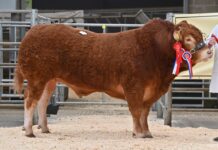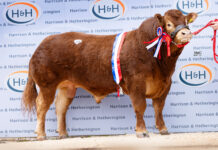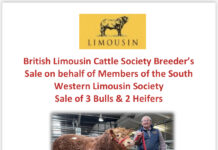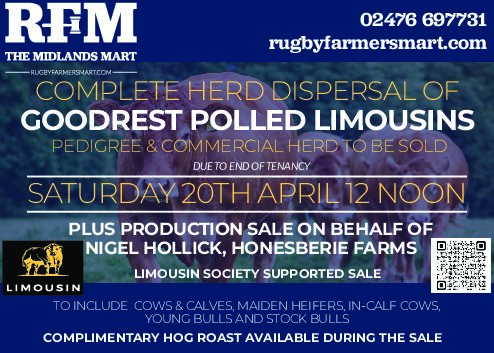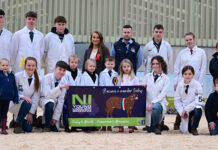ILC Visit – The Robertsons of Northumberland
One of the largest teams of working Limousin bulls in England is owned by brothers David and Iain Robertson of Alnwick, Northumberland.
They run ten Limousin bulls as service sires in their herds which jointly total over 400 commercial cows, 90% of which are Limousin-sired.
David and Iain farm three units – Shipley, Embleton and Stamford, totalling 2,500 acres. This part of Northumberland, England’s most north easterly county, lends itself to mixed farming. In addition to the cattle enterprise, the Robertsons grow 800 acres of cereals, predominantly spring barley, and run 2,200 ewes.
 Limousins were first introduced into the Robertson farming enterprise by David and Iain’s father – G.E. (Seorus). Now retired, he and his wife Eileen, still live on the farm at Shipley. However, not only did Seorus, a Royal Air Force Squadron Leader, (1940 – 46), introduce Limousins to his own farm, he played a major role in the introduction of the Limousin breed to the British cattle industry. In 1967, having been dis-illusioned for some years with the lack of size and poor fertility of the Angus and Hereford bulls he and his fellow Northumbrian cattle producers had been buying,
Limousins were first introduced into the Robertson farming enterprise by David and Iain’s father – G.E. (Seorus). Now retired, he and his wife Eileen, still live on the farm at Shipley. However, not only did Seorus, a Royal Air Force Squadron Leader, (1940 – 46), introduce Limousins to his own farm, he played a major role in the introduction of the Limousin breed to the British cattle industry. In 1967, having been dis-illusioned for some years with the lack of size and poor fertility of the Angus and Hereford bulls he and his fellow Northumbrian cattle producers had been buying,
Seorus applied to the British Ministry of Agriculture to import Limousin bulls from France. He planned to use them in his commercial herd. Initially a negative Ministry raised numerous objections, but had not bargained for the dogged determination of Seorus and the team of cattle-minded allies he had gathered around him. In one of his many persuasive communications, Seorus outlined his views as to “some of the better reasons for importing Limousin bulls” –
 He detailed the ease of calving, thanks to a light birth weight and small head. He explained that in their homeland, Limousin cattle lived outside and as Limoges is 950 feet above sea level, with an annual rainfall of 60 inches and an average October – April temperature colder than Acklington in Northumberland, there was no doubting their hardiness. His most profound paragraph reads like a 21st Century promotional blue print for what has become known as “The Carcase Breed”.
He detailed the ease of calving, thanks to a light birth weight and small head. He explained that in their homeland, Limousin cattle lived outside and as Limoges is 950 feet above sea level, with an annual rainfall of 60 inches and an average October – April temperature colder than Acklington in Northumberland, there was no doubting their hardiness. His most profound paragraph reads like a 21st Century promotional blue print for what has become known as “The Carcase Breed”.
Seorus wrote –
“ The most important reason is that the Limousin produces first class, well marbled quality beef, with a fine grain and a comparatively low proportion of bone and fat, coupled with a very good growth and live weight gain in an early maturing carcase. The Limousin is a butchers animal, having a long carcase with an abundance of meat from the best cuts, ribs and hindquarters, together with a very good killing out percentage”.
Those words were written over 35 years ago and 22 months before the first Limousins arrived in Britain. The bovine qualities which so greatly impressed Seorus Robertson then, are today still the foundation of all that is good about Limousin cattle. The result – December 1970, 154 pedigree Limousin heifers and 24 bulls the autumn born calves going at 12 – 14 months and spring-born at 18 months.
The Robertson family is one of the very few British families who have had over 30 years of experience of working with Limousin cross cattle. This family started and has been closely involved all the way, with the Limousin revolution which has swept through British beef production. Their own cattle enterprise reflects the pattern of many 21st Century British beef herds – Limousin bulls over Limousin-blooded females.
 David Robertson commented – “Over the years we’ve enjoyed competing in local prime cattle shows and in one of the biggest carcase competitions in Europe – the Scottish National Premier Meat Exhibition at Scotbeef’s abattoir near Stirling, where the overall quality has improved dramatically, to the stage where outstanding quality is the norm. “There simply isn’t another breed which has the versatility to be the terminal sire of top quality beef while also being able to sire excellent suckler replacements”.
David Robertson commented – “Over the years we’ve enjoyed competing in local prime cattle shows and in one of the biggest carcase competitions in Europe – the Scottish National Premier Meat Exhibition at Scotbeef’s abattoir near Stirling, where the overall quality has improved dramatically, to the stage where outstanding quality is the norm. “There simply isn’t another breed which has the versatility to be the terminal sire of top quality beef while also being able to sire excellent suckler replacements”.
When Seorus Robertson won his battle to import Limousin bulls, it was with his own cattle enterprise in mind. History now shows that with his letter of 28th July 1967, Seorus made the first turn of a key which unlocked the door to a breed, which is now, numerically, the most popular cattle breed, beef or dairy, in Britain.
On behalf of British Limousin cattle enthusiasts, the British Limousin Cattle Society is proud to pay tribute to not only Seorus Robertson’s vision and perception, but also to his courage to back his convictions and fight until the battle to import Limousins was won.
The result – in less than 35 years Seorus Robertson has seen British Limousin- sired cattle go from Zero to millions, making Limousin the most popular cattle breed throughout the land.


